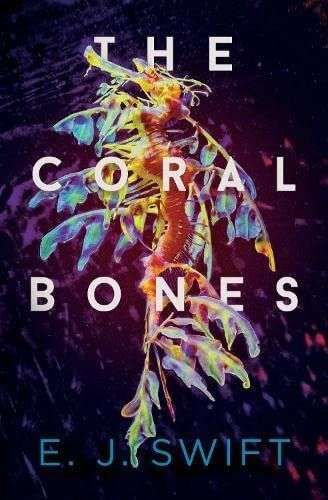The Coral Bones by E.J. Swift.
Unsung Stories, £9.99
Review by Nadya Mercik

“…we are not living for ourselves but borrowing from the future. Our borrowing has long exceeded a safe limit. We are shitting in our own house, shovelling the shit to the next room when the stink grows too great – and running out of rooms.â€
E. J. Swift’s The Coral Bones is a piercing and acute novel which cannot leave you indifferent. It rages like a stormy ocean, but it also offers you a serene picture of the world’s beauty – something not to be lost. Reading it is like surfing a big wave – exhilarating and mindful.
The story starts with a shocking event when Hana Ishikawa finds a corpse covered in white paint on an inflatable inscribed with the message – “That is what it looks like when coral dies.†Truly shocked by this encounter with death, she goes to find the dead man’s wife. Donna Kelly has never shared her husband’s passion for the sea and the Great Barrier Reef, so she gives Hana a huge trunk filled with clippings and copies of materials about the GBR. However, Hana is not in the best place to deal with that inheritance at the moment. She has a personal trauma she is going through, which appears on the pages of her diary, which she addresses to her ex-partner Tess.
Hana’s narrative is the one happening around our time when the extinction catastrophe unfolds. She is profoundly touched by nature’s tragedy, which got its symbolic representation in the corpse of Jack Kelly. She is trying to reconcile with the event, to get to its roots, to understand what’s to be done next, but the grief of it spills into her personal life, mixes with the failed relationship and at times almost paralyse her. Hana’s is the story of wavering faith and the found belief and energy to try and remedy things.
To contrast Hana’s voice, Swift weaves in the second narrative – that of Judith Holliman. She is a daughter of an English captain, born and raised in Australia in the first half of the 19th century. She has a spirit of true exploration and persuades her father to take her on his next expedition to the GBR. This is the time when corals are still in their prime beauty, unspoiled by climate change and human technology. With curiosity and the child’s excitement, Judith, who is very knowledgeable about nature and different species, observes and documents the new world in her diary. Her path is not an easy one, for as a woman of the Victorian era, she cannot be recognised and accepted as a true naturalist and scientist. She has to battle against gender inequality, proving herself time and again. However, she does it with unwavering enthusiasm and determination. In some ways, she is Hana’s precursor – the woman Hana used to be before the grief fell over her.
The third voice of Telma Velasco comes from the future. She inhabits the world our generations left behind them. It is not an easy world to live in. Humans have left the wild and are agglomerated in the cities. They do their best to try and restore the planet, but it is a slow and painful process. Telma, hunted by the death of her daughter, who perished in a wildfire saving others, works for the Restoration Committee. She is a lone warrior, driving her truck amidst the desert and completing missions. But her new one takes her to the ocean in search of the ghost of a seadragon. Telma is still pained by the state of the world, but in a way, she has come to terms with it. She does her best to try and improve it. Telma is Hana’s echo – someone Hana would become when she managed her grief.
Swift incorporates the three different voices of women brilliantly. Together they build the story arc of the fight for the coral reefs, starting from their discovery to their restoration. The personal traumas of Hana and Telma are closely connected to the bigger tragedy of the world, while Judith’s serves as a fusee. In Judith’s world, nature is still intact, but we already see how sailors are ready to kill manta rays because they could be dangerous and how even Judith welcomes the advance of steam technologies.
Despite being steeped in grief and regret, the novel is more like Judith – hopeful and promising in the end. As E.J. Swift says, “Books may not save us, but perhaps they can help us process.†This novel gives you a picture of what is happening and what might happen in the future. Having done extensive research on the coral reefs, their conservation and human-assisted evolution, the author offers us a scenario which is made very personal through the lives of these three women. Being lyrical, the novel at the same time offers you mysteries to be unsolved and adventures to be lived through. The book has touched me on so many levels that I am sure I will return to it more than once.

